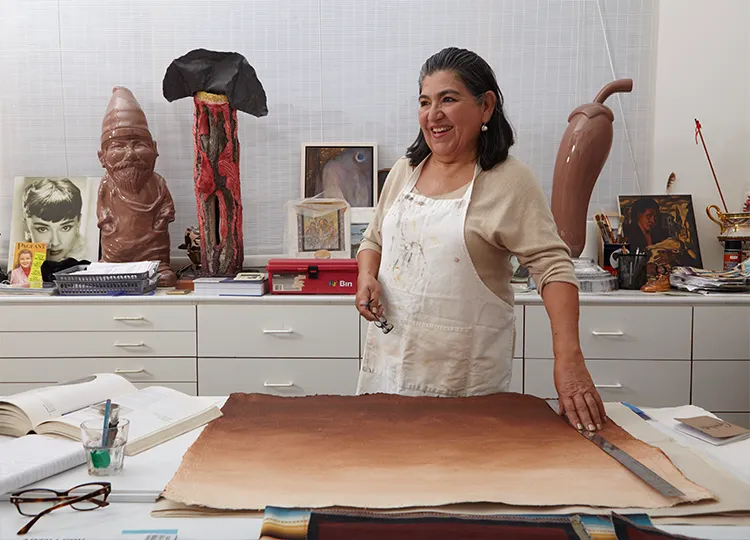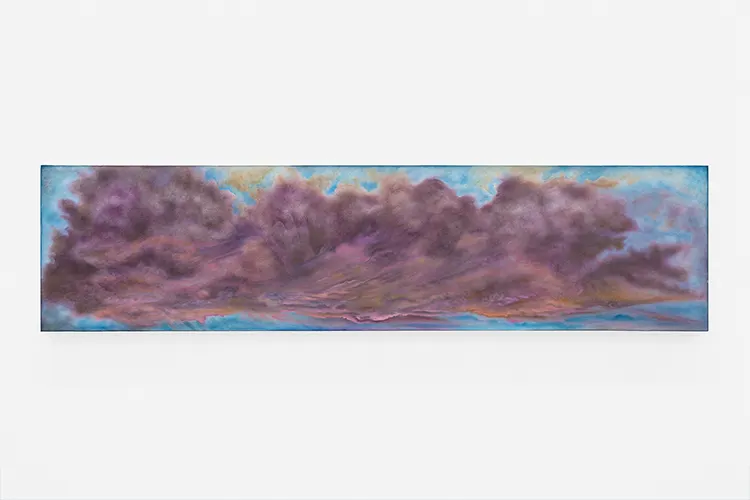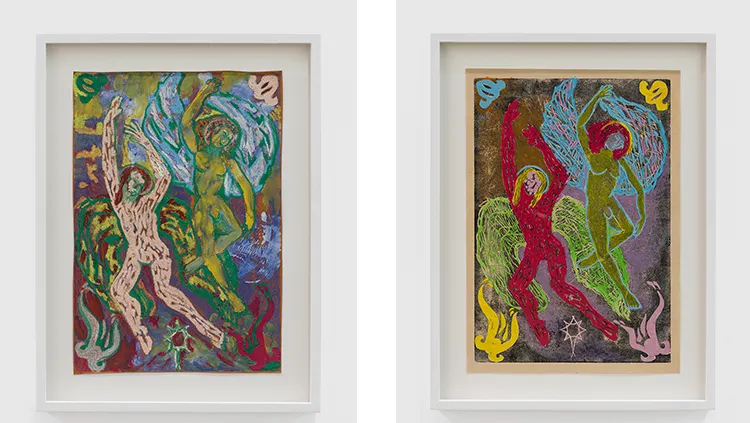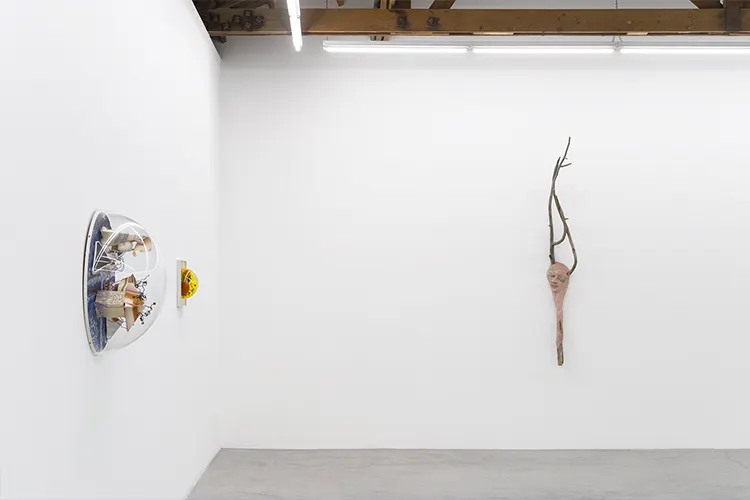“I believe that all women are a part of the earth and can be inspired by a relationship with and through nature.”
A Vision Rooted in Earth and Spirit
Linda Vallejo’s artistic journey is deeply interwoven with themes of cultural identity, spirituality, and humanity’s intrinsic connection to nature. Over five decades, her work has served as a testament to the enduring influence of indigenous traditions, eco-feminist perspectives, and Chicana identity in contemporary art. Represented by parrasch heijnen in Los Angeles, Vallejo does not merely create visual compositions—she constructs narratives that honor the past while critically engaging with the present.
Her artistic philosophy is grounded in the belief that women embody the essence of the earth, drawing strength, wisdom, and resilience from nature. This perspective is evident in her early sculptural experiments of the 1970s, where she explored indigenous influences and the ceremonial aspects of Mesoamerican heritage. These pieces, often composed of prints and found materials, took on three-dimensional forms that evoked the spiritual and structural integrity of ancient pyramids. Through this work, Vallejo initiated a dialogue between past civilizations and contemporary artistic practice, laying the foundation for a career defined by cultural reclamation and transformation.
Beyond material exploration, Vallejo’s work is a conduit for personal and collective memory. Her engagement with indigenous rituals, particularly after joining the danzante group Flores de Aztlán in 1977, further solidified her commitment to honoring ancestral knowledge through artistic expression. Immersing herself in Aztec and Maya ceremonial practices, she developed a profound understanding of how cultural heritage shapes identity. Her 1977 work Mi Cultura encapsulates this transformation, utilizing Aztec symbols such as corn and the sun to represent the cyclical nature of life, where the physical body becomes a bridge between past and future generations.

Linda Vallejo: Nature, Identity, and the Sculptural Form
The natural world serves as both subject and material in Vallejo’s artistic investigations. Nowhere is this more evident than in her Tree People series (1980-1990), where she sought to reimagine humanity’s relationship with nature through sculptural forms. By repurposing tree fragments found in Los Angeles, Vallejo breathed new life into discarded organic matter, creating hybrid figures that blurred the boundaries between human and arboreal existence. The series posed a fundamental question: What if people acknowledged their undeniable connection to nature rather than positioning themselves above it?
Her work El Pacal (1990) exemplifies this concept. In this piece, an ethereal figure appears to emerge from the wood, its form indistinct yet evocative, gazing skyward in a silent dialogue with the cosmos. The choice of material—rescued tree fragments combined with pulped paper—recalls indigenous traditions where trees are seen as sacred beings imbued with spiritual significance. Vallejo’s sculptural practice thus becomes an act of reclamation, reaffirming the sacredness of nature in an era of increasing environmental and cultural alienation.
Vallejo’s affinity for organic materials extends beyond wood. Throughout her career, she has embraced a diverse range of media, allowing concept to dictate form. Whether working with ceramics, paint, or mixed media, her process remains intuitive, guided by an intrinsic understanding of how materials can convey both historical continuity and contemporary urgency. This adaptability underscores her ability to navigate the intersections of tradition and modernity, using artistic practice as a means of cultural storytelling.

The Cosmos and the Digital Shift
The 1990s marked a shift in Vallejo’s exploration of identity and spirituality, particularly in relation to the vastness of the cosmos. Her Los Cielos series (1995-2008) reflects a deep meditation on humanity’s place within the universe, with female figures seamlessly integrated into celestial landscapes. These paintings evoke a sense of belonging that transcends the physical world, urging viewers to contemplate the interconnectedness of life, memory, and the unknown. The interplay of vibrant color and ethereal form in works such as Solitary Cloud I (2007) conveys a delicate yet powerful spiritual presence—an invitation to consider the unseen forces that shape existence.
As technology began reshaping cultural narratives, Vallejo’s work evolved to address the growing divide between human experience and the digital world. Her ongoing series Self-Knowing in the New Age (2023-present) employs pixel abstraction to create psychological portraits that question the implications of technological immersion. Here, she critiques the ways in which digital interfaces mediate human perception, often distancing individuals from their natural selves. This thematic inquiry builds upon her earlier Brown Dot Project, which transformed statistical data on Latino demographics in the United States into visual abstractions, merging sociopolitical discourse with aesthetic experimentation.
Her recent work Reflection on Immortality, 2024 (2024) expands on these concerns, suggesting that while digital culture offers an illusion of permanence, true immortality resides in the wisdom passed down through generations and in nature itself. By juxtaposing contemporary anxieties with ancestral knowledge, Vallejo positions her art as both a critique of modernity and a reaffirmation of enduring cultural values.

Linda Vallejo: Art as Cultural and Political Discourse
Throughout her career, Vallejo has embraced art as a means of sociopolitical engagement. Her commitment to Chicana and indigenous perspectives is not merely thematic—it is woven into the very fabric of her practice. As one of the early art educators at Self-Help Graphics Barrio Mobile Art Studio in the mid-1970s, she played a pivotal role in fostering artistic expression within the Latino community of East Los Angeles. This early experience reinforced her belief in the power of art to uplift marginalized voices and preserve cultural heritage.
Her Make ‘Em All Mexican series, which preceded The Brown Dot Project, exemplifies her approach to cultural critique through visual intervention. By reimagining historical figures and pop culture icons with brown skin, she challenges mainstream narratives and questions the erasure of Latino presence in American history. This body of work underscores her ability to merge humor, irony, and activism, creating a space for dialogue around identity and representation.
Currently, Vallejo continues to push the boundaries of artistic discourse through her sculptural series The New Gods. In this ongoing project, she juxtaposes Mesoamerican ceremonial incense burner forms with modern symbols of political, religious, and cultural ideologies. By merging ancient and contemporary belief systems, she invites reflection on the persistence of power structures and the ways in which historical narratives inform present-day realities. This interplay between past and present defines Vallejo’s oeuvre, reinforcing her role as an artist whose work not only preserves tradition but also challenges the constructs of modernity.

The post Linda Vallejo: Reclaiming Identity, Earth, and Spirit Through Art appeared first on AATONAU.
+ There are no comments
Add yours